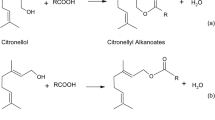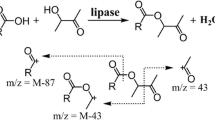Abstract
Candida antarctica lipase fraction B (CAL-B) showed substrate specificity in the synthesis of esters in hexane involving reactions of short-chain acids having linear (acetic and butyric acids) and branched chain (isovaleric acid) structures, an unsaturated (tiglic acid) fatty acid, and phenylacetic acid with n-butanol and geraniol. The variation in the conversion to the esters was ca. 10%. Similar results were observed in a study of the alcohol specificity of the enzyme for esterification of acetic and butyric acids with four alcohols: n-butyl, isopentyl, 2-phenylethyl, and geraniol. Enantioselectivity of CAL-B in hexane with a range of chiral α-substituted or β-substituted carboxylic acids and n-butyl alcohol was analyzed. The results show that CAL-B can be employed as a robust biocatalyst in esterification reactions due to the high conversions obtained in the synthesis of short-chain flavor esters in an organic solvent, although this enzyme exhibited modest enantioselectivity with chiral short-chain carboxylic acids.




Similar content being viewed by others
References
Bornscheuer UT, Kazlauskas RJ (1999) Hydrolases in organic synthesis: regio- and stereoselective biotransformations. Wiley–VCH, Weinheim, p 107
Claon PA, Akoh CC (1994) Enzymatic synthesis of geranyl acetate in n-hexane with Candida antarctica lipases. J Am Oil Chem Soc 71:575–578
Gillies B, Yamazaki H, Armstrong DW (1987) Production of flavor esters by immobilized lipase. Biotechnol Lett 10:709–714
Gotor V (2002) Biocatalysis applied to the preparation of pharmaceuticals. Org Proc Res Dev 6:420–426
Haraldsson GG (1992) The application of lipases in organic synthesis. In: Patai S (ed) The chemistry of functional groups, supplement B: the chemistry of acid derivatives, vol 2. Wiley, New York, pp 1395–1473
Langrand G, Rondo TN, Triantaphylides C, Baratti J (1990) Short chain flavor esters synthesis by microbial lipases. Biotechnol Lett 12:581–586
Miller C, Auistin H, Posorske L, Gonzalez J (1988) Characteristics of an immobilized lipase for the commercial synthesis of esters. J Am Oil Chem Soc 65:927–931
Molinari F, Villa R, Aragozzini F (1998) Production of geranyl acetate and other acetates by direct esterification catalyzed by mycelium of Rhizopus delemar in organic solvent. Biotechnol Lett 20:41–44
Paiva AL, Van Rossum D, Malcata FJ (2002) Kinetics of lipase-mediated synthesis of butyl butyrate in n-hexane. Biocatal Biotransfor 20:43–51
Welsh FW, Williams RE, Dawson KH (1990) Lipase mediated synthesis of low molecular weight flavor esters. J Food Sci 55:1679–1683
Acknowledgments
The authors thank the National Council on Technological Education, Mexico (CoSNET) for financial support (grants nos. 607.96-P and 856.98-P).
Author information
Authors and Affiliations
Corresponding author
Rights and permissions
About this article
Cite this article
Larios, A., García, H.S., Oliart, R.M. et al. Synthesis of flavor and fragrance esters using Candida antarctica lipase. Appl Microbiol Biotechnol 65, 373–376 (2004). https://doi.org/10.1007/s00253-004-1602-x
Received:
Revised:
Accepted:
Published:
Issue Date:
DOI: https://doi.org/10.1007/s00253-004-1602-x




